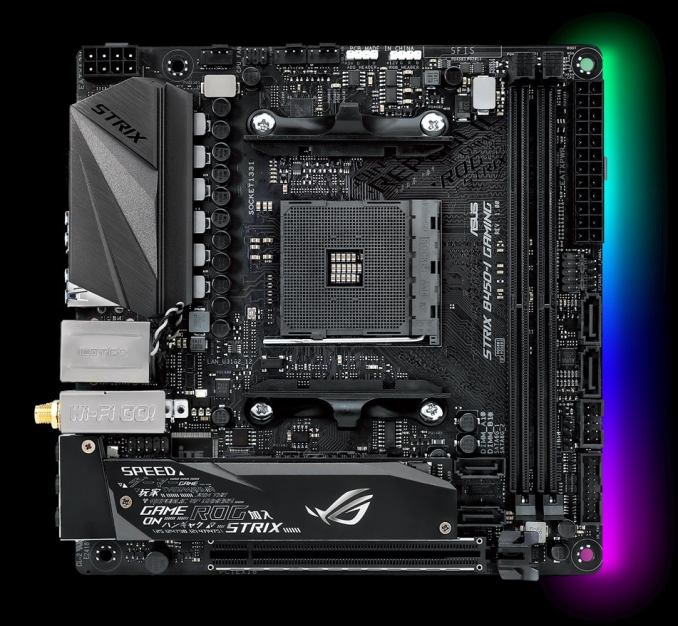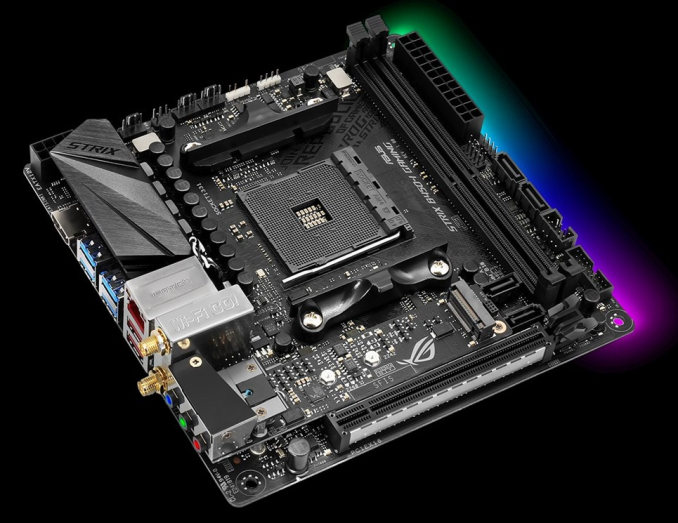Analyzing B450 for AMD Ryzen: A Quick Look at 25+ Motherboards
by Gavin Bonshor on July 31, 2018 8:00 AM ESTASUS ROG Strix B450-I Gaming
While the B450-I is the smaller sibling of the Strix B450-F, it packs a mighty punch in feature sets with a host of good quality components usually found on mITX form factor boards over the years from ASUS. The Strix B450-I includes a ROG SupremeFX S1220A audio codec with dual operational amplifiers, an Intel I211-AT Gigabit LAN controller and an Intel 802.11ac Wi-Fi adapter with MIMO capabilities built-in.
Looking closer at the Strix B450-I, the general theme follows that of the Strix B450-F board. The Strix B450-I follows a more subtle and clandestine style primarily due to its size, with a metallic grey heatsink which sits above the rear panel and MOSFETs. The RGB lighting built-in spans across the right-hand side of the board offers a unique and customizable under glow thanks to the ASUS Aura Sync technology which means it can be synchronized up with compatible peripherals and components such as graphics cards. On top of this are a single addressable RGB header and a regular RGB header.
Due to the size limitations on smaller form factor motherboards such as this one, there is only a single full-length PCIe 3.0 x16 slot which is covered in ASUS’s SafeSlot metallic armor coating to protect against slot damage from the heavier load bearing graphics cards.
Focusing on memory support, the smaller form factor has its benefits in this department as the ROG Strix B450-I supports up to DDR4-3600 with a maximum capacity of up to 32 GB of system memory split across two memory slots. Smaller form factor boards from ASUS generally tend to perform well in the memory stakes due to the closer tracks between the CPU socket and the RAM slots themselves, usually giving the memory lower latencies; although the benefits are marginal at best in real-world scenarios, they make quite a difference in situations such as benchmarking and sub-zero overclocking.
Touching more on the power capabilities, the Strix B450-I seems to feature an 8 phase Digi+ power delivery in a 6+2 configuration, with an 8-pin ATX 12 V power input to power the processor. In addition to this is a standard 24-pin ATX power connector featured on the right-hand side of the board.
The ASUS ROG Strix B450-I has a combined total of three 4-pin connectors spread across a dedicated header for a CPU fan, a single chassis fan connector and a specific connector for an AIO CPU cooler pump, or water cooling pump. Like most B450 motherboards, this particular model has a simple clear CMOS jumper instead of a button and has the capability to increase the number of USB ports through internal headers by a further two USB 3.1 5 Gbps and two USB 2.0 ports.
Making up the storage options on the Strix B450-I are four SATA 6 Gbps ports with all four of them being angled straight out of the board; we find two each on either side of the memory slots. The SATA 6 Gbps ports offer support for RAID 0, 1 and 10 arrays. In addition to the available SATA ports is a duo of M.2 slots with both slots accommodating drives up to M.2 2280 (22 x 80 mm), and both supporting the PCIe 3.0 x4 interface. One of the slots is located just above the full-length PCIe 3.0 x16 slot and features an integrated M.2 heatsink which has the futuristic text. The second slot is located on the rear of the PCB and features no cooling options other than available passive cooling from the system its installed into.
The audio is the same ROG SupremeFX S1220A audio codec found on the B450-F but is also supplemented by a pairing of operational amplifiers to further enhance the sound. Due to the size limitations, the SupremeFX S1220A codec only allows a total of three 3.5mm audio jacks on the rear panel, but they do contain an element of LED illuminated goodness; if that’s considered a selling point for an ITX board. In addition to the audio capabilities, the rear panel also has a total of four USB 3.1 5 Gbps Type-A ports and a pairing of USB 3.1 10 Gbps Type-A ports which are distinguished by their red color.
Finishing off the connections on the ROG Strix B450-I is an Intel I211-AT controlled Gigabit LAN port, two slots to attach the two included antennas to capitalize on the built-in 802.11ac MIMO 2T2R capable Wi-Fi module with Bluetooth 4.2 support, and last but most certainly not least, a single HDMI 2.0b capable video output for use with the Ryzen APUs.
It’s clear that the ROG Strix B450-I is a formidable offering featuring the same 8-phase Digi+ power delivery with two more than most ASUS B450 boards at launch, as well as a svelte integrated M.2 heatsink offering some function to users looking to utilize an NVMe capable drive in a small form factored PC, as well as some points in the style stakes too. The B450-I would be more suited to a powerful gamer with a beefy pixel rendering goliath such as an NVIDIA GTX 1080 Ti paired off with a Ryzen 2700X processor and DDR4-3600 memory for a pocket rocket gaming system. The expected retail price is currently unknown as of yet.





_thumb.jpg)
_thumb.jpg)
_thumb.jpg)
_thumb.jpg)
_thumb.jpg)
_thumb.jpg)








62 Comments
View All Comments
theanalyzer - Tuesday, July 31, 2018 - link
Signed up to point that out. Needs to be fixed. It’s the only ITX board supporting 2x which sets it’s apart form the competitionDeath666Angel - Tuesday, July 31, 2018 - link
Glad to see more options in the mATX range with two M.2 slots, not just from AsRock this time around. My next rig will either be based on the AsRock B450M Pro4 or one of the MSI B450M Mortar boards. Will wait for actual VRM setup and overclocking results / general tests to see which one will be it. I had motherboards from both manufacturers and was pleased with both. MSI has the advantage of offering PCIe M.2 options for both slots as well as SATA. One question regarding that: if I install a 3.0 PCIe x2 M.2 SSD into a 2.0 PCIe x4 slot, what will be the speed ramifications? Can it only use 2.0 PCIe x2 or can it use the full x4, thus being similar in speed to a native 3.0 PCIe x2 setup? :) Still waiting on mATX x470 mainboards.Outlander_04 - Tuesday, July 31, 2018 - link
.3.0 x 2 is the same speed as 2.0 x 4DanNeely - Tuesday, July 31, 2018 - link
Except that a 3.0 x2 drive is almost certainly x2 because it only has 2 PCIe lanes (cutting down on them is one of the ways the cheaper drives pinch pennies), which means it will be connected at 2.0 x2; at that point you might as well just use a SATA drive and save a bit more money.Death666Angel - Tuesday, July 31, 2018 - link
Thanks for providing an answer to my actual question. :)AdrianB1 - Tuesday, July 31, 2018 - link
You will get a 2 lane PCIe 2.0 connection, that means 1 GB/s. This is 1/4 of a PCIe 3.0 4-lane usual NVME drive, but real life you may get closer to 80% of the performance.Death666Angel - Tuesday, July 31, 2018 - link
Thanks!Outlander_04 - Tuesday, July 31, 2018 - link
Finally some budget boards with solid VRMs.skpetic - Tuesday, July 31, 2018 - link
There are some seriously shady stuff going on with VRMS om X470 og B450. Check out Buildzoid on youtube. Asus B450 STRIX ITX board is single phase for SoC. Several of the Gigabyte B450 and X470 boards in reality have half the advertised amount of phases or are using doublers:https://www.youtube.com/watch?v=3IjWCOXSuKU
meacupla - Tuesday, July 31, 2018 - link
hahaha... noAsus with the absolute trash tier VRM heatsinks
AsRock with fake phases
Gigabyte with fake phases and trash VRM heatsinks
MSI with no Vcore offset